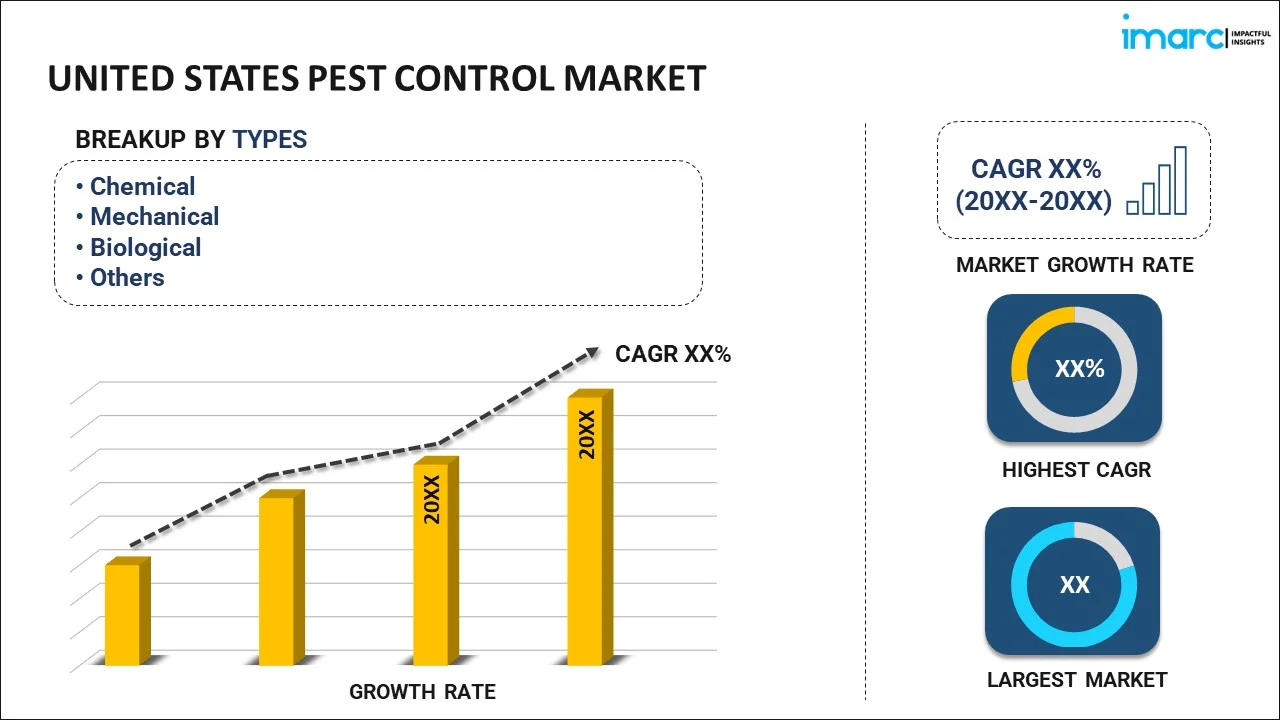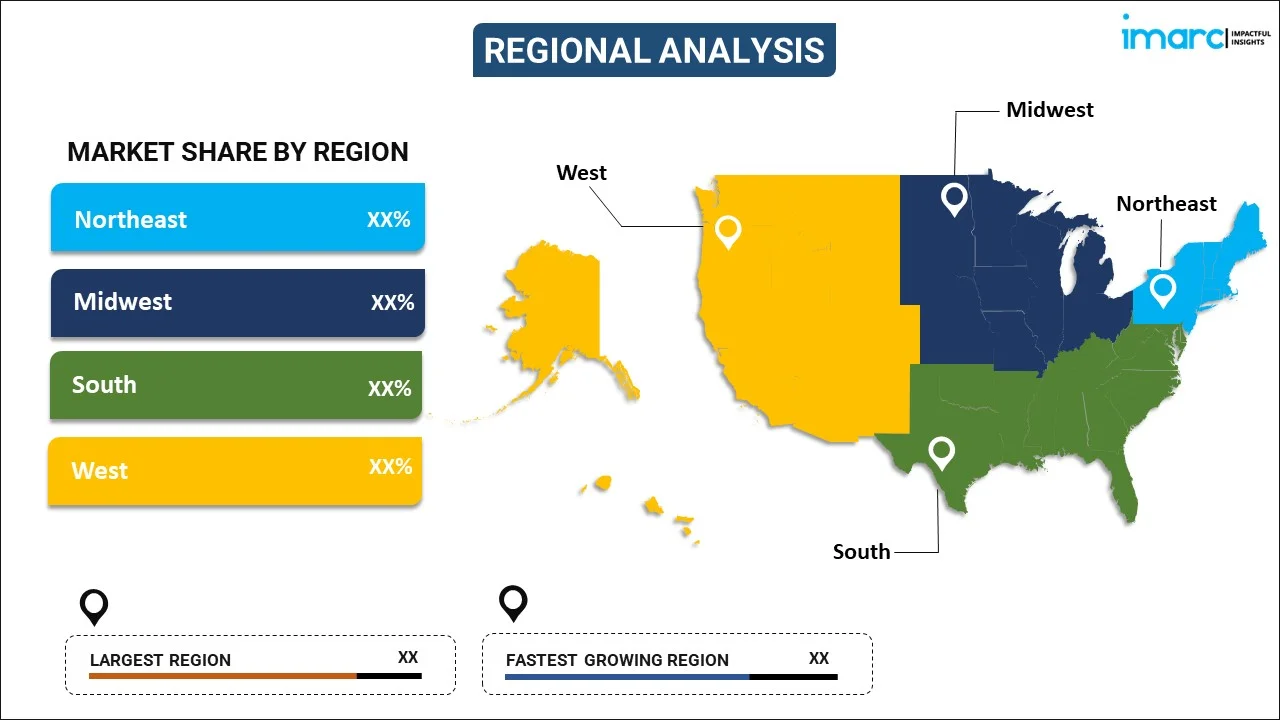
United States Pest Control Market Report by Type (Chemical, Mechanical, Biological, and Others), Pest Type (Insects, Termites, Rodents, and Others), Application (Residential, Commercial, Agriculture, Industrial, and Others), and Region 2025-2033
Market Overview:
United States pest control market size reached USD 6.1 Billion in 2024. Looking forward, IMARC Group expects the market to reach USD 9.6 Billion by 2033, exhibiting a growth rate (CAGR) of 5.2% during 2025-2033. The increasing awareness among the masses about the health risks associated with pests, the growing environmental consciousness among individuals, and the expansion of farmland and agribusiness operations represent some of the key factors driving the market.
|
Report Attribute
|
Key Statistics
|
|---|---|
|
Base Year
|
2024 |
|
Forecast Years
|
2025-2033
|
|
Historical Years
|
2019-2024
|
| Market Size in 2024 | USD 6.1 Billion |
| Market Forecast in 2033 | USD 9.6 Billion |
| Market Growth Rate (2025-2033) | 5.2% |
Pest control involves the ongoing process of identifying, managing, and mitigating pests such as insects, rodents, and other unwanted organisms that can adversely affect humans, agriculture, and the environment. It helps prevent the spread of diseases carried by pests, reducing health risks. It safeguards crops, ensuring higher yields and food security. It prevents structural damage to buildings caused by pests like termites. It minimizes allergenic substances produced by pests, improving indoor air quality. It helps safeguard native flora and fauna by preventing the introduction of invasive species that can disrupt ecosystems. It is widely used in industrial settings to ensure uninterrupted operations and prevent damage to machinery, leading to higher productivity.
United States Pest Control Market Trends:
The increasing awareness among the masses in the United States about the health risks associated with pests represents one of the primary factors catalyzing the demand for pest control services in residential and commercial sectors. Along with this, the growing environmental consciousness among individuals is driving the demand for eco-friendly pest control methods that minimize chemical use and environmental impact. Apart from this, continuous innovations in pest monitoring and control methods, such as smart traps and data-driven solutions, are strengthening the growth of the market. Furthermore, several pest control companies in the United States are adopting advanced monitoring systems, the Internet of Things (IoT) devices, and data analytics to track pest activity more accurately. These technologies enable proactive pest management, allowing businesses to identify and address issues before they become major infestations. Data-driven insights also help optimize pest control strategies and reduce the overall use of chemicals. In line with this, many companies in the U.S. are leveraging e-commerce platforms and digital marketing to reach a wider audience. Online booking systems, informative websites, and targeted digital advertising are making it easier for individuals to access pest control services. Along with this, the increasing use of pest control solutions in the hospitality industry, including hotels, restaurants, and resorts, to maintain clean and pest-free environments for guests is creating a positive outlook for the market. Moreover, the increasing movement of goods across borders is increasing the risk of introducing new pests, driving the need for stricter pest control measures in supply chains. Besides this, the expansion of farmland and agribusiness operations in the United States is driving the need for pest control to protect crops from diseases. In addition, several pest control companies in the country are increasingly investing in education and training programs for their technicians to handle complex pest issues and provide effective solutions. They are also forming partnerships with sustainability-focused organizations and initiatives. These collaborations promote environmentally responsible pest control practices and help companies align with broader sustainability goals.
United States Pest Control Market Segmentation:
IMARC Group provides an analysis of the key trends in each segment of the market, along with forecasts at the country level for 2025-2033. Our report has categorized the market based on type, pest type, and application.
Type Insights:

- Chemical
- Mechanical
- Biological
- Others
The report has provided a detailed breakup and analysis of the market based on the type. This includes chemical, mechanical, biological, and others.
Pest Type Insights:
- Insects
- Termites
- Rodents
- Others
A detailed breakup and analysis of the market based on the pest type have also been provided in the report. This includes insects, termites, rodents, and others.
Application Insights:
- Residential
- Commercial
- Agriculture
- Industrial
- Others
The report has provided a detailed breakup and analysis of the market based on the application. This includes residential, commercial, agriculture, industrial, and others.
Regional Insights:

- Northeast
- Midwest
- South
- West
The report has also provided a comprehensive analysis of all the major regional markets, which include Northeast, Midwest, South, and West.
Competitive Landscape:
The market research report has also provided a comprehensive analysis of the competitive landscape. Competitive analysis such as market structure, key player positioning, top winning strategies, competitive dashboard, and company evaluation quadrant has been covered in the report. Also, detailed profiles of all major companies have been provided.
United States Pest Control Market Report Coverage:
| Report Features | Details |
|---|---|
| Base Year of the Analysis | 2024 |
| Historical Period | 2019-2024 |
| Forecast Period | 2025-2033 |
| Units | Billion USD |
| Scope of the Report | Exploration of Historical and Forecast Trends, Industry Catalysts and Challenges, Segment-Wise Historical and Predictive Market Assessment:
|
| Types Covered | Chemical, Mechanical, Biological, Others |
| Pest Types Covered | Insects, Termites, Rodents, Others |
| Applications Covered | Residential, Commercial, Agriculture, Industrial, Others |
| Regions Covered | Northeast, Midwest, South, West |
| Customization Scope | 10% Free Customization |
|
Post-Sale Analyst Support |
10-12 Weeks |
| Delivery Format | PDF and Excel through Email (We can also provide the editable version of the report in PPT/Word format on special request) |
Key Questions Answered in This Report:
- How has the United States pest control market performed so far and how will it perform in the coming years?
- What has been the impact of COVID-19 on the United States pest control market?
- What is the breakup of the United States pest control market on the basis of type?
- What is the breakup of the United States pest control market on the basis of pest type?
- What is the breakup of the United States pest control market on the basis of application?
- What are the various stages in the value chain of the United States pest control market?
- What are the key driving factors and challenges in the United States pest control?
- What is the structure of the United States pest control market and who are the key players?
- What is the degree of competition in the United States pest control market?
Key Benefits for Stakeholders:
- IMARC’s industry report offers a comprehensive quantitative analysis of various market segments, historical and current market trends, market forecasts, and dynamics of the United States pest control market from 2019-2033.
- The research report provides the latest information on the market drivers, challenges, and opportunities in the United States pest control market.
- Porter's five forces analysis assist stakeholders in assessing the impact of new entrants, competitive rivalry, supplier power, buyer power, and the threat of substitution. It helps stakeholders to analyze the level of competition within the United States pest control industry and its attractiveness.
- Competitive landscape allows stakeholders to understand their competitive environment and provides an insight into the current positions of key players in the market.
Need more help?
- Speak to our experienced analysts for insights on the current market scenarios.
- Include additional segments and countries to customize the report as per your requirement.
- Gain an unparalleled competitive advantage in your domain by understanding how to utilize the report and positively impacting your operations and revenue.
- For further assistance, please connect with our analysts.
 Inquire Before Buying
Inquire Before Buying
 Speak to an Analyst
Speak to an Analyst
 Request Brochure
Request Brochure
 Request Customization
Request Customization




.webp)




.webp)












